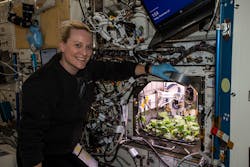Regular readers of LEDs Magazine will know that we periodically check in on the International Space Station to see what might be new in horticultural lighting research up there. Given the recent arrival of a new team of US astronauts, now seemed like a good time to have a look.
Sure enough, we found action. We will be upfront in telling you that we don't have a whole lot of detail to report, but we thought that you might like to know that amid all the fanfare of Elon Musk's private taxi service to the ISS, other detailed work such as the studying of LED lighting's effect on plant growth continues.
In a daily NASA update of activity, blogger Catherine Williams wrote on Nov. 20 that “Flight Engineer Kate Rubins collected radish leaf samples being grown inside the Advanced Plant Habitat.”
We don't know what US astronaut Rubins did or plans to do with the radish leaves, although we suspect she set them aside for later analysis by earthly scientists. All we know for sure from the blog is that after she gathered them, she changed tasks altogether, refocusing her attention on water tanks and filters in a life support rack. It's a busy scientific life at 220 miles above Earth.
As a review,: the Advanced Plant Habitat (APH) is one of at least four experimental plant growing systems using tunable LED lighting aboard the ISS. The four projects also examine factors other than lighting, such as nutrients and growth medium.
Like other research on the craft in general, the idea is to see how things perform and behave in microgravity, as the world gets ready for life at new frontiers. Knowing more about how to grow edible fruits and vegetables in the far yonder could go a long way to sustaining human life there.
And the findings in many of the areas, certainly including plant growth, are expected to help improve operations on Earth, where there is plenty of interest in tunable LED horticultural lighting.
The APH, as we reported in June, offers richer spectral content than another of the ISS' plant growing initiatives, called Veggie PONDS. APH provides red, green, blue, and also white, far-red, and infrared (for nighttime imaging) wavelengths, according to NASA. One aspect of plant growth of particular interest in the APH project is lignin, which is a natural polymer that gives structure and rigidity to plants, analogous to the role of bones in people (for more information, click on the link at the beginning of this paragraph).
The APH is an enclosed chamber that astronauts open to gather a harvest that they typically freeze or chemically fix for later analysis on terra firma. The chamber includes cameras and over 180 sensors connected to Kennedy Space Center, which operates it remotely.
By comparison, the less spectrally diverse Veggie PONDS is an open chamber managed by the onboard crew and allowing them to freely reach in and snip things to eat, such as romaine lettuce and mizuna mustard greens.
A third onboard system, called BRIC-LED, uses tunable LEDs to study the effect of space on plants’ immune systems. It is the latest version of the ISS’ Biological Research in Canisters (BRIC) facility, which has been used to study organisms small enough to grow in petri dishes, such as yeast and microbes.
A fourth project, called Spectrum-001, uses white and tunable LEDs to nurture the growth of small plants and yeasts in petri dishes. The specimens are first genetically modified on Earth to include fluorescent proteins, which provide markers picked up by different wavelengths of light emitted by Spectrum. The initiative is as much about testing the imaging system as it is about studying plant growth.
Radish pruner Rubins, by the way, did not travel up in the SpaceX Crew Dragon capsule that reached the ISS on Nov. 16 after a 27-hour flight launched in Florida with three astronauts from the US and one from Japan. She was already there, having arrived on Oct. 14 after hitching a ride from Kazakhstan's Baikonur Cosmodrome along with two Russian cosmonauts.
MARK HALPER is a contributing editor for LEDs Magazine, and an energy, technology, and business journalist ([email protected]).
For up-to-the-minute LED and SSL updates, why not follow us on Twitter? You’ll find curated content and commentary, as well as information on industry events, webcasts, and surveys on our LinkedIn Company Page and our Facebook page.






